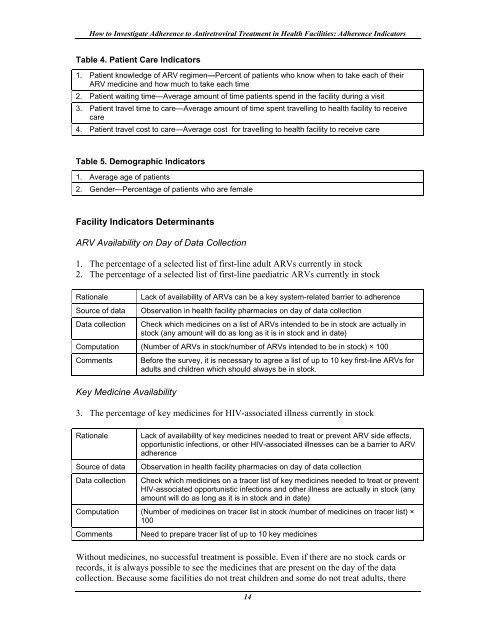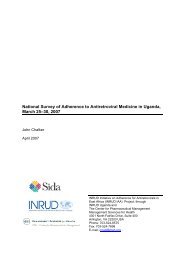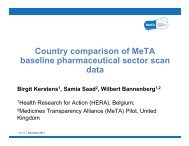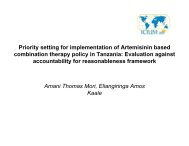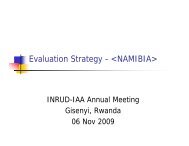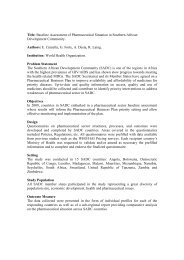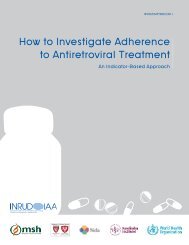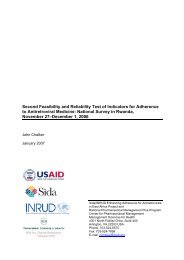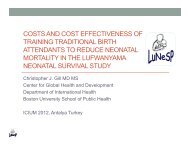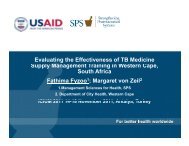How to investigate Adherence to Antiretroviral Treatment ... - INRUD
How to investigate Adherence to Antiretroviral Treatment ... - INRUD
How to investigate Adherence to Antiretroviral Treatment ... - INRUD
Create successful ePaper yourself
Turn your PDF publications into a flip-book with our unique Google optimized e-Paper software.
<strong>How</strong> <strong>to</strong> Investigate <strong>Adherence</strong> <strong>to</strong> <strong>Antiretroviral</strong> <strong>Treatment</strong> in Health Facilities: <strong>Adherence</strong> Indica<strong>to</strong>rs<br />
Table 4. Patient Care Indica<strong>to</strong>rs<br />
1. Patient knowledge of ARV regimen—Percent of patients who know when <strong>to</strong> take each of their<br />
ARV medicine and how much <strong>to</strong> take each time<br />
2. Patient waiting time—Average amount of time patients spend in the facility during a visit<br />
3. Patient travel time <strong>to</strong> care—Average amount of time spent travelling <strong>to</strong> health facility <strong>to</strong> receive<br />
care<br />
4. Patient travel cost <strong>to</strong> care—Average cost for travelling <strong>to</strong> health facility <strong>to</strong> receive care<br />
Table 5. Demographic Indica<strong>to</strong>rs<br />
1. Average age of patients<br />
2. Gender—Percentage of patients who are female<br />
Facility Indica<strong>to</strong>rs Determinants<br />
ARV Availability on Day of Data Collection<br />
1. The percentage of a selected list of first-line adult ARVs currently in s<strong>to</strong>ck<br />
2. The percentage of a selected list of first-line paediatric ARVs currently in s<strong>to</strong>ck<br />
Rationale<br />
Source of data<br />
Data collection<br />
Lack of availability of ARVs can be a key system-related barrier <strong>to</strong> adherence<br />
Observation in health facility pharmacies on day of data collection<br />
Check which medicines on a list of ARVs intended <strong>to</strong> be in s<strong>to</strong>ck are actually in<br />
s<strong>to</strong>ck (any amount will do as long as it is in s<strong>to</strong>ck and in date)<br />
Computation (Number of ARVs in s<strong>to</strong>ck/number of ARVs intended <strong>to</strong> be in s<strong>to</strong>ck) × 100<br />
Comments<br />
Key Medicine Availability<br />
Before the survey, it is necessary <strong>to</strong> agree a list of up <strong>to</strong> 10 key first-line ARVs for<br />
adults and children which should always be in s<strong>to</strong>ck.<br />
3. The percentage of key medicines for HIV-associated illness currently in s<strong>to</strong>ck<br />
Rationale<br />
Source of data<br />
Data collection<br />
Lack of availability of key medicines needed <strong>to</strong> treat or prevent ARV side effects,<br />
opportunistic infections, or other HIV-associated illnesses can be a barrier <strong>to</strong> ARV<br />
adherence<br />
Observation in health facility pharmacies on day of data collection<br />
Check which medicines on a tracer list of key medicines needed <strong>to</strong> treat or prevent<br />
HIV-associated opportunistic infections and other illness are actually in s<strong>to</strong>ck (any<br />
amount will do as long as it is in s<strong>to</strong>ck and in date)<br />
Computation (Number of medicines on tracer list in s<strong>to</strong>ck /number of medicines on tracer list) ×<br />
100<br />
Comments<br />
Need <strong>to</strong> prepare tracer list of up <strong>to</strong> 10 key medicines<br />
Without medicines, no successful treatment is possible. Even if there are no s<strong>to</strong>ck cards or<br />
records, it is always possible <strong>to</strong> see the medicines that are present on the day of the data<br />
collection. Because some facilities do not treat children and some do not treat adults, there<br />
14


